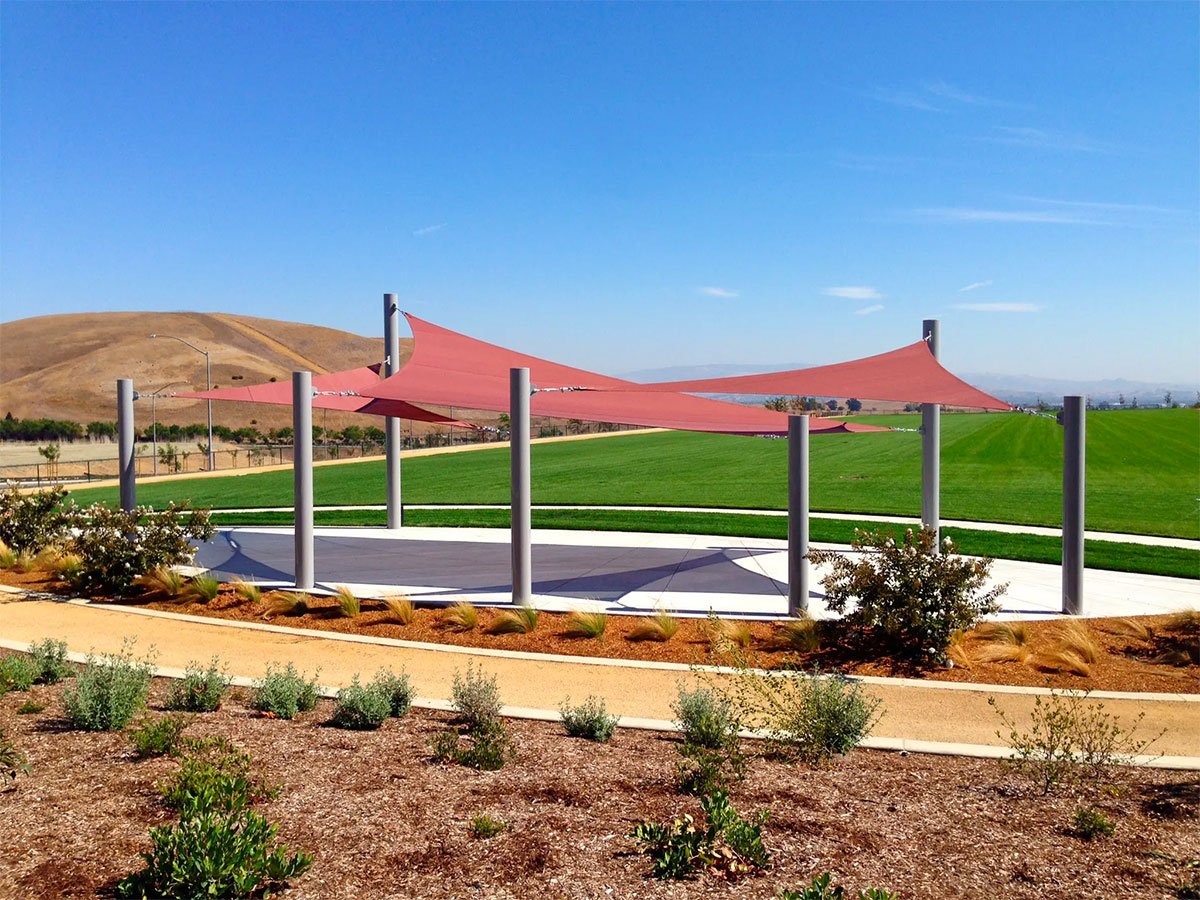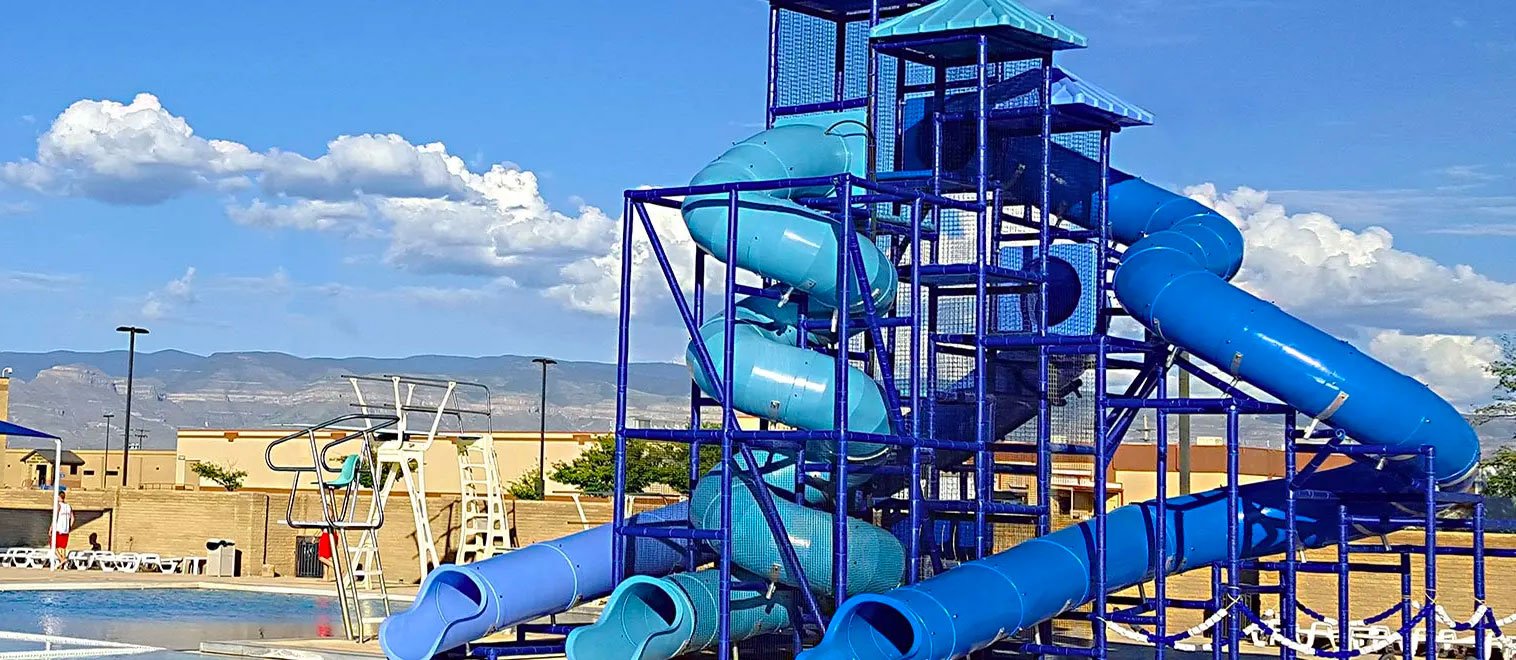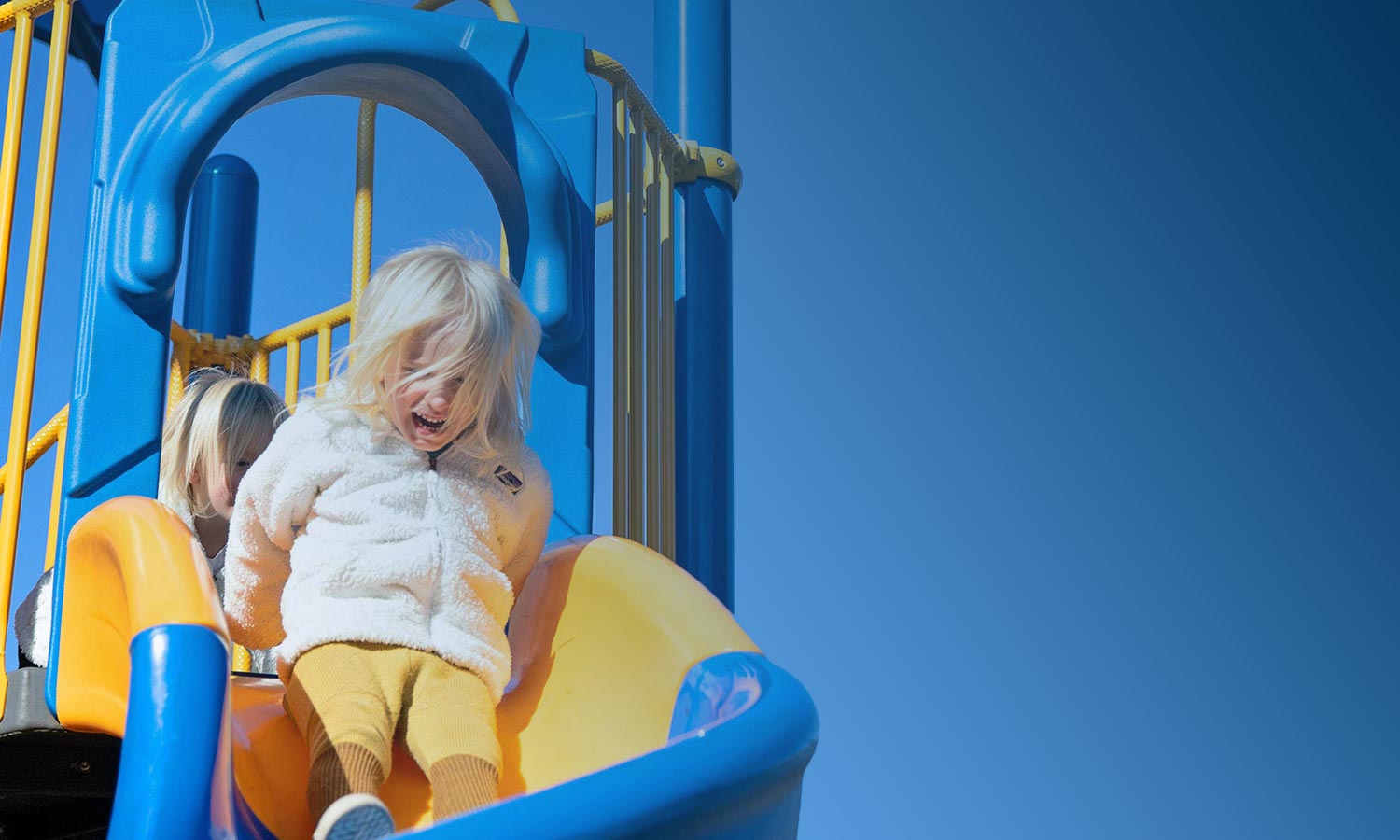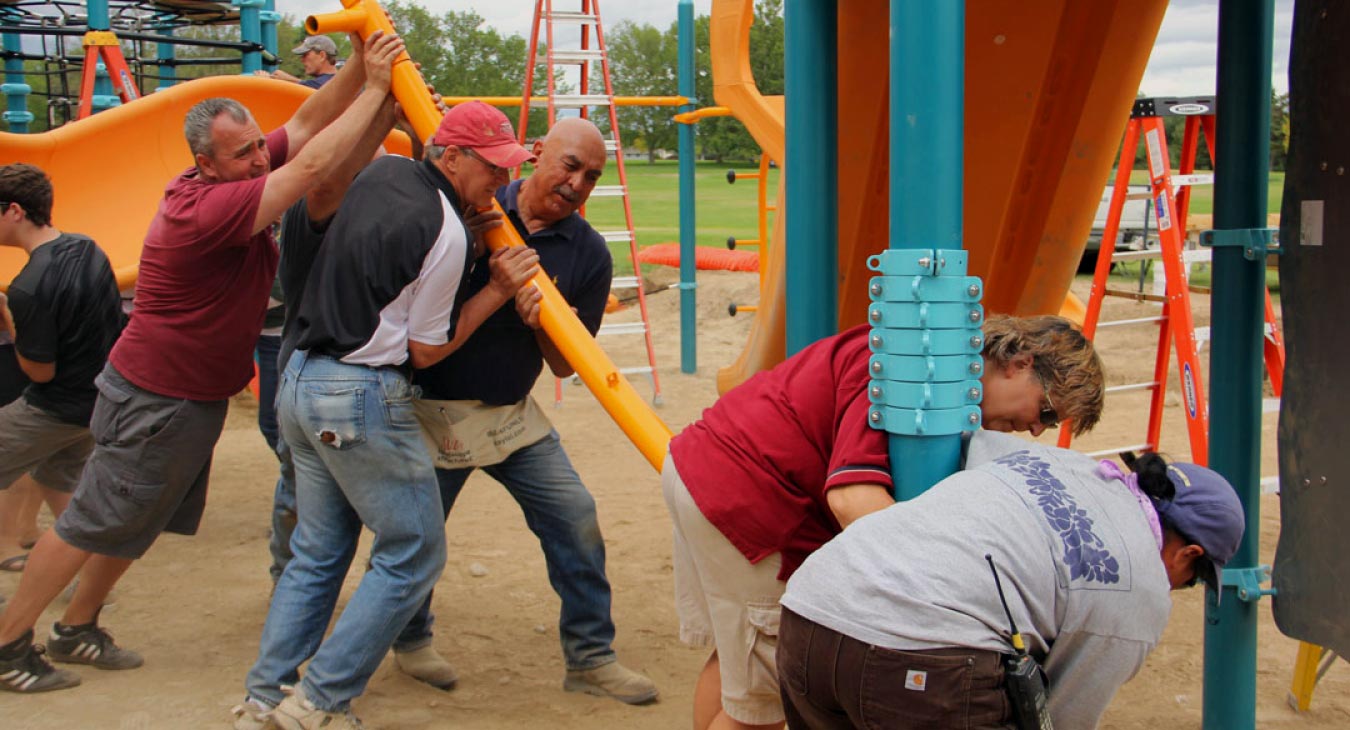Beyond providing a fun and safe space for children to engage in physical play, playgrounds serve as vital communal spaces that promote social interaction among parents and caregivers. Apart from providing an opportunity to socialize, playgrounds are also vital in promoting inclusiveness and community building. This article aims to educate families, educational facilities, and communities on the importance of and benefits provided by playgrounds.
It’s Not All Fun and Games
Playgrounds are not just spaces for kids to play and have fun; they also play a vital role in building strong and engaged communities. Playgrounds are also crucial in building strong, engaged communities. In the United States, 74% of residents live within a walkable distance of a park or recreation area—and for good reason. Aside from promoting health and wellness, playgrounds and parks are ideal places where people can gather and mingle, ultimately uniting communities.
When people interact with one another, they form connections and establish social networks, which help to create a sense of belonging and foster a sense of community. With regular interactions, people in the community develop a sense of trust and mutual support. They are more likely to work together to achieve common goals. This fosters a sense of community pride and involvement, making the neighborhood a more vibrant and cohesive place to live.
The Importance of Physical Play and Socialization
According to a survey conducted by the National Recreation and Park Association (NRPA) in 2021, 90% of adults reported that parks and playgrounds provide important opportunities for children to learn and practice social skills, such as sharing and cooperation.
Playground equipment provides children with these opportunities. For instance, when children share playground equipment, they must learn to take turns and communicate effectively with their peers. When kids engage in team games or collaborative play, they must learn to work together and rely on one another. These experiences can help to build social skills and promote positive peer relationships.
Physical play helps children connect, which ultimately leads to building meaningful friendships and relationships.
What Makes an Inclusive and Diverse Playground?
Playgrounds need to be inclusive to ensure that children of all abilities can fully participate in play activities.
A recent study has shown that inclusive playgrounds have a positive impact on developing children’s physical, social, and emotional needs. Children with special needs were able to achieve moderate- or higher-intensity exercise and heart rates on an inclusive playground. The study concludes that both typically developing children and those with disabilities will benefit from play areas where they can mingle and participate in parallel play with others.
Now, what makes an inclusive playground? Ideally, this should feature equipment and play spaces that children with disabilities can easily access, such as wheelchair-accessible ramps, sensory play areas, and swings with high backs and harnesses. These playgrounds should also feature equipment that children with different abilities can use, such as equipment with adjustable heights and sensory play components catering to children with autism.
The Role of Playgrounds in Community Building and Engagement
Playgrounds serve as important community gathering spaces where parents and caregivers can connect and engage with one another while their children play. According to an Old Dominion University study, community parks and playgrounds have a positive impact on building a strong sense of community and social cohesion.
In addition, community playgrounds provide opportunities for parents and caregivers to engage in social interactions and build social networks, leading to increased social support and a sense of belonging. This can be particularly important to families with limited social resources.

How Playgrounds Encourage Social Interactions among Kids
Socialization contributes to a child’s growth and development. Through social interactions, children learn how to communicate effectively, empathize with others, and develop healthy relationships. They also learn how to manage their emotions, understand social cues, and build self-esteem.
Besides educational institutions, recreational areas like parks and playgrounds provide the perfect setting for kids to develop their social skills through play.
Opportunities for Social Interaction on Playgrounds
Playgrounds offer numerous opportunities for children to engage in social interaction, which is essential to their development.
Sharing playground equipment. By sharing equipment, children learn to take turns and negotiate with one another, which are important social skills. Plus, playgrounds often provide opportunities for collaborative play, where children work together toward a common goal. For instance, building a sandcastle or navigating an obstacle course encourages teamwork and cooperation.
Engaging in collaborative play. Team games like basketball, soccer, and tag require children to work together and communicate effectively to win. These games help children develop leadership skills as they learn to take charge of a team or collaborate with others to achieve success.
Playing in a group. Group play involves larger groups of children engaging in imaginative and creative play, such as role-playing or creating their own games. This promotes friendships and socialization, developing soft skills such as communication, cooperation, and empathy.
Benefits of Social Interaction on Playgrounds
Playgrounds help promote social interaction among children, which, in turn, provides a ton of benefits to their overall well-being. Such benefits include the following:
Improves social skills and relationships. According to a study published in the journal Child Development, social play in children promotes better relationships with peers and develops social skills.
Enhances cognitive and emotional development. Social interaction on playgrounds helps children to develop cognitive and emotional skills such as empathy, communication, problem-solving, and self-regulation. A Pediatrics research article also suggests that play activities involving social interaction may help children develop emotional regulation and cognitive flexibility.
Encourages physical activity. Children are more likely to engage in physical activity when they have the opportunity to interact with their peers on playgrounds. An Oxford Academic journal article found that children who engaged in social play on playgrounds had higher levels of physical activity than those who engaged in solitary play.
Boosts self-esteem and confidence. Social interaction on playgrounds can improve children’s self-esteem and confidence. According to a report by the International Journal of Environmental Health Research, nature-based playtime helps children to build confidence, self-esteem, and a sense of self-worth.
Develops their problem-solving skills. Social interaction on playgrounds offers children the opportunity to practice problem-solving skills. Playgrounds often provide a safe and supportive environment where children can experiment with different social scenarios and learn from their mistakes. Through these experiences, children can develop important social-emotional skills that can help them navigate challenges and solve problems in their everyday lives.
How Playgrounds Facilitate Social Interaction
When talking about playgrounds, design plays a key role. A playground’s design influences how a child is going to use it and how they respond to others. A well-designed playground should invite children to have fun, get some exercise, and engage with their friends and classmates, not the other way around.
It takes careful planning and consideration to design an effective playground, especially one that’s inclusive of all children’s needs. Playground designers need to consider the layout, equipment, and landscaping to effectively build a safe and enjoyable space for everyone.
There are plenty of play equipment types for playgrounds that facilitate physical, social, and imaginative play. These are a few examples:
- Swings. A staple on almost every playground, swings provide an opportunity for children to experience the sensation of movement and build core strength.
- Slides. Slides are another classic playground staple that allows children to practice gross motor skills and build confidence.
- Climbing structures. They can come in many forms, such as ropes, ladders, and rock walls, allowing children to develop balance, coordination, and problem-solving skills.
- Spinners. A type of playground equipment that spins when children push or pull them, spinners provide a fun and engaging sensory experience.
- Balance beams. This type of equipment requires children to walk across a narrow beam, helping them to develop balance and coordination.
- Spring riders. Children can sit and bounce on spring riders, promoting physical activity and imaginative play.
- Gaga pits. An octagonal or hexagonal arena enclosed with walls where children play a modified version of dodgeball, gaga pits have recently grown in popularity. They are inclusive and can be played by children of all ages and abilities.
Overall, providing safe, accessible, and inclusive playgrounds creates a significant impact on children and their development throughout the years. With access to effective spaces, they are able to hit their physical, mental, and social milestones better.
How Playgrounds Encourage Social Interactions among Parents
Aside from boosting children’s friendships and morale, playgrounds greatly impact the relationships of parents in the community too. Parks and recreational spaces encourage connections with other parents, cultivating a sense of community and belonging. Let’s not forget about how social interaction improves mental health by reducing stress and emotional support.
Observation and Supervision
Parents are responsible for supervising their children while they play on playgrounds, ensuring they are safe and following playground rules. In the United States, more than 220,000 children aged 14 and below visit the emergency rooms to treat injuries from playing on playgrounds. With strong parental supervision, this number can significantly reduce.
Plus, parents can encourage their children to engage in social interaction with other children on the playground, which can promote social and emotional development. Parents can also model positive behaviors, such as sharing and taking turns, which can help children learn these important social skills. By supervising their children on playgrounds, parents can ensure that their children are safe and learning important social and emotional skills.
Group Play and Activity
Aside from facilitating play for their children, parents can also join in on the fun by participating in group games and activities with other parents. Whether at school excursions or community events, parents can be involved in activities such as parent-child relay races, group games, and other team-oriented activities. This is also an excellent opportunity to work with their children and promote a sense of teamwork, collaboration, and social skills. By being more involved in their children’s activities, parents develop more instances to bond with their children and develop stronger community relationships.
Community Building
Playgrounds make great areas for community-building activities and events. There are plenty of ways families can connect with one another at parks and recreational areas, such as holding potlucks, picnics, or sports fests. Other ideas to consider include these:
- Community cleanup. A park cleanup day is a great opportunity for families to work together to pick up litter and improve the cleanliness of the community.
- Family fun night. Families can bring picnic dinners and participate in group games and activities.
- Storytime. Invite a local storyteller or children’s author to go to the playground and read stories to children and families.
- Nature walk. A guided nature walk through a nearby park or nature trail encourages families to explore and appreciate the natural environment.
- Community art project. Families can work together to create a mural or sculpture to display at the playground.
- Sports tournaments. Organize family sports fests such as kickball or soccer games, encouraging families to work together and build teamwork skills.
- Family fitness classes. Family fitness classes, such as yoga or aerobics, promote physical activity and healthy living.
These activities not only promote community building and social interaction among families but also encourage a sense of ownership and pride in the playground and the larger community. Overall, playgrounds not only support the holistic well-being of children but also play vital roles in ensuring strong community ties.
Shaping Children and Communities through Playgrounds
It’s no news how playgrounds play a key role in encouraging exercise and socialization among children. But beyond that, these seemingly innocent spaces greatly impact how families are shaped and communities are built. Within these areas, parents are able to communicate their thoughts and experiences with one another. All these are important aspects in building a close-knit, empathetic community that looks out for one another when the need arises.
With this, it’s essential for schools and communities to invest in creating safe, effective playgrounds that not only invite children to play but also their parents to socialize. This small addition to an area may eventually leave a huge impact on the community as a whole.
References
- Barton, J., G. Sandercock, J. Pretty, and C. Wood. 2015. “The Effect of Playground- and Nature-Based Playtime Interventions on Physical Activity and Self-Esteem in UK Schoolchildren. International Journal of Environmental Health Research 25 (2): 196–206. https://doi.org/10.1080/09603123.2014.915020
- Centers, Kimberly T. 2019. “An Exploration of the Relationships between Sense of Community, Park Benefits, and Neighborhood Park Use.” PhD diss, Human Movement Sciences, Old Dominion University, DOI: 10.25777/n29w-0a85. https://digitalcommons.odu.edu/hms_etds/40
- National Recreation and Park Association. n.d. “Parks and Recreation Is Essential.” https://www.nrpa.org/our-work/building-a-movement/parks-and-recreation-is-essential/
- Nidirect. 2022. “How Play Helps Children’s Development. https://www.nidirect.gov.uk/articles/how-play-helps-childrens-development
- OrthoInfo. n.d. “Playground Safety Guide.” https://orthoinfo.aaos.org/en/staying-healthy/playground-safety-guide/
- Ridgers, N. D., L. L. Carter, G. Stratton, and T. L. McKenzie. 2011. “Examining Children’s Physical Activity and Play Behaviors during School Playtime over Time.” Health Education Research 26 (4): 586–595. https://doi.org/10.1093/her/cyr014
- Smith, M. 2023. “Social Support for Stress Relief.” HelpGuide.org. https://www.helpguide.org/articles/stress/social-support-for-stress-relief.htm
- Stevens, W., J. Borchard, P. Sleeper, D. Dempsey, K. A. Jeans, C. Jo, and K. Tulchin-Francis. 2023. “Inclusive Community Playgrounds Benefit Typically Developing Children: An Objective Analysis of Physical Activity.” Frontiers in Sports and Active Living. https://doi.org/10.3389/fspor.2022.1100574
- Whitman, Elizabeth. 2018. “The Impact of Social Play on Young Children.” Integrated Studies 94. https://digitalcommons.murraystate.edu/bis437/94
- Yogman, M. W., A. J. P. Garner, J. W. Hutchinson, K. Hirsh-Pasek, and R. M. Golinkoff. 2018. The Power of Play: A Pediatric Role in Enhancing Development in Young Children.” Pediatrics 142 (3): 2018–2058. https://doi.org/10.1542/peds













